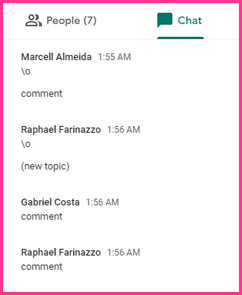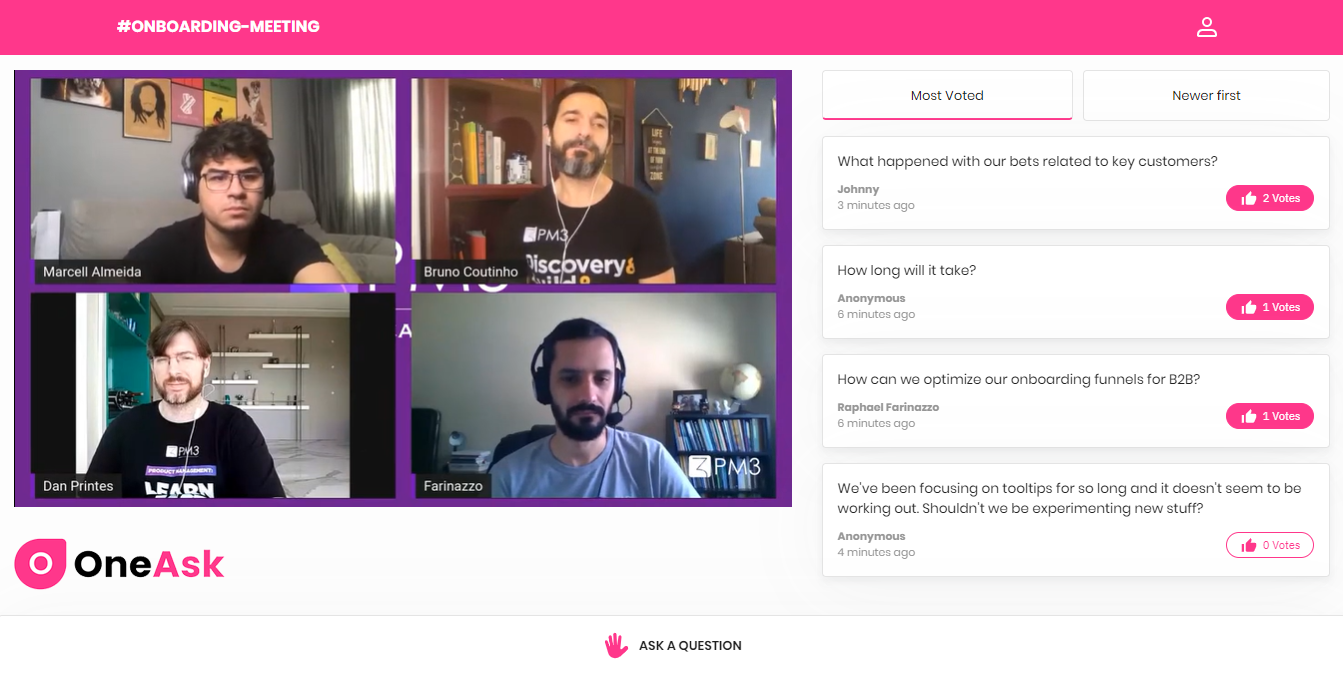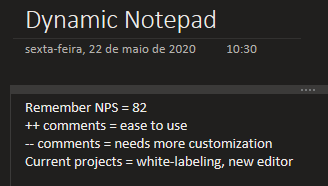How to keep the experience of face-to-face meetings on online meetings
June 3, 2020
COVID-19 has accelerated the move to digital in most companies. Even among those that already enabled employees to work remotely, in most cases, face-to-face meetings continued to exist, with a small screen (or screen) to design only the remote ones.
However, since March 2020, we are (almost) everyone at home, and at the time of writing this post, we do not know how long we will be like this, nor how things will be in the post-crisis.
Probably a lot will change, and one of them is the practice of meetings.
Meetings have always brought problems, for sure, and you may have heard or thought, "this meeting could have been an email"!
Still, some matters require a lot of conversation, so meetings will continue to be important for all companies.
The problems that have arisen with the popularization of online meetings need to be contained as soon as possible for the sake of all workers' sanity!
In this post, we have separated some tips for you to take your meetings online. Come on:
Punctuality
That's a subject that has a lot of company culture. Many companies see punctuality as an obligation, especially in meetings involving executives and other professionals with busy schedules. However, there are still many companies with a lot of tolerance for delays. Depending on the company's country of origin, punctuality can be left out.
At OneAsk, we bet on productivity! Undoubtedly, punctuality is a crucial factor in keeping everyone productive. In addition to ensuring the best use of time and favoring those who plan their day well, it also reduces the stress and anxiety of waiting for late colleagues.
That does not mean cutting off some informal conversation at the beginning of some meetings. They often help to break the ice, especially in times of social isolation.
Just be careful not to get too far. For 45-minute to 1-hour meetings, where everyone knows each other, five minutes of ice breaker is more than enough.
In-person, if you have two meetings in a row in different rooms, it can take a long time to arrive, which delays the start of the next meeting and can end up impacting the rest of your day. Online, however, delays have few valid justifications! (Unless you have children. Then, we know things can be chaotic!)
Therefore, reinforce your discipline to be on time for meeting times.
Presentations: pass the word on to the next person on the list
When attendants don't know each other, a few words to present themselves is very common in a face-to-face meeting. Just a change of eyes for everyone to know when they can speak or a simple turn around the table guarantees the experience.
However, in online meetings, there is no table to move clockwise.
However, in online meetings, there is no table to move clockwise.
We recommend that the person responsible for scheduling or facilitating the meeting start by introducing himself, demonstrating the tone and time available for each one, and then calling each person in the order of names or videos on the screen.
That prevents two people from starting to speak at the same time or long periods of silence when each one is waiting for the other to begin.
If your meeting does not have a "responsible" or facilitator, each person who introduces herself can choose the next person to speak, among those who have not yet spoken.
Use a single line of people raising hands
Raising your hand is excellent practice (unfortunately, rarely used) for face-to-face meetings. It favors that everyone has a voice, even introverts, and prevents more influential personalities from monopolizing the word or interrupting at all times.
So, combine a line and call people in order.
Here, we use the chat, but some tools are already introducing "raise hand" features and queue management options.
Open a new topic or comment on the current?
One of the problems with "raise hand" features is that they can cut out some of the meeting's dynamism.
Sometimes people raise hands to open a new topic!
Sometimes people raise hands to open a new topic!
At other times, people may raise their hands because they want to talk about the current topic, but they end up in the last places in the queue. When they get their chance, the subject has already changed, or someone else already said what they would.
In these cases, a combination that works well is: when you raise your hand, be explicit about what you intend to bring, using messages such as "new topic" or "comment topic X" or "comment what Ana is saying".
Mind the chat!
It's tempting: instead of waiting for my turn, why don't I type everything I want to say?
Avoid this and ask people not to!
It will create confusion, disperse people's attention, and interrupt the speaker.
Think about it: someone is expressing their opinion to 20 people in an online meeting, for example. You go and comment on the chat. At this point, 8 or 10 people stop paying attention to the speaker to read your message. Not only you caught the attention of these 8 or 10 people but were also disrespectful of the speaker. Imagine that minutes later, another 4 or 5 people will read what you wrote, but already out of context, and will disperse even more.
Chat is an excellent tool for online meetings, but we believe it as a support tool for sending links, quick comments, or raising hands.
Have a single source of questions
Imagine that you invited everyone to this online meeting because you need to present the results of a study or project.
Which of the following approaches looks best?
- "I'll be presenting, and you can ask questions in between."
- "I'll present this topic, and we do a Q&A afterward."
- "I'll present this topic while you leave questions in the chat."
The answer is none!
The first one breaks a lot of the dynamics of an exhibition and risks opening a long conversation, making it difficult to return to the central topic.
The second can make people forget the questions because when the lecture ends, they are still processing the entire narrative. Or, if they have any questions during the presentation, they might stop paying attention to you to think about the question.
The third has all the problems associated with the chat, as we mentioned in the previous topic. Besides, the order of questions is not always the priority of the meeting, and chat features do not allow people to elect the most relevant questions.
Our tip is to use OneAsk as the only source of questions and doubts. There, people can send questions during their presentation without interruption and still vote for the most relevant ones.
Therefore:
"I will present, and you can ask or vote on questions in the meantime. In the end, I will respond by order of votes."
What if I don't have time to answer them all?
As a good practice, we recommend that you answer by text all questions that did not fit in the meeting. After all, those doubts still exist.
That also favors a proper follow-up of the meeting and everything that was discussed.
Mic off when listening, please!
That is a fundamental rule that cannot be broken!
Even if you live alone, even if your house is quiet, even if not a single car passes by in your neighborhood, a mute mic ensures that no unforeseen circumstances will be part of everyone's experience.
Is it your turn to speak? Unmute and speak up! Finished? Go back to mute!
And if you can, turn the camera on
The experience of an online meeting is much better if you can look at the people you are talking to. So, when you're not speaking, ensure that experience for others. The speaker will be able to see you, your expressions, your interest.
Messy room or tousled hair shouldn't be a reason - after all, you've always combed (or never cared about it) to work in person, right?
The most justified exception to being without a camera in an online meeting is the speed of the connection. Other than that, show your face in the meeting room!
Do not stretch: speak with beginning, middle and end
In a face-to-face meeting, if you stretch, it is much easier for someone to subtly interrupt, and thank you for your speech. Or at least it becomes more evident, in the physiognomic and corporal expression of people, the discontent with your long exposure.
Online, it is still possible to send these signals, but they are more complicated.
So don't monopolize the microphone!
A practical tip: if you have already raised your hand but your turn has not yet come, you can quickly prepare, in Notepad or similar, the topics of everything you want to talk about:
That way, you won't forget anything, and you already have a previous idea of how long it will take to say everything. If too much, consider cutting out a few topics.
The summary also helps not to repeat anything that someone else has said before you. In fact, if everything you are going to say has already been said, consider passing your turn or quickly completing any relevant information.
No multitasking
It is already inelegant to use your cell phone in a face-to-face meeting, right?
Online, it is not because no one will notice that you should give in to any of the countless temptations. A few clicks away, all those browser tabs or those unanswered messages suddenly seem to be important.
The illusion of multitasking strikes profoundly during an online meeting. We seem to be saving time, working "twice for once".
But the truth is that if there is nothing useful in the meeting, you shouldn't have agreed to attend it. And if there is anything worthwhile, you shouldn't be paying attention to other things.
It looks like it won't be a problem, but sooner or later, someone will quote your name, and you will have no idea what was going on before!
So, no multitasking! Be 100% present at meetings.
Liked it? Have any tips that are working in your context of online meetings? Share with us!







